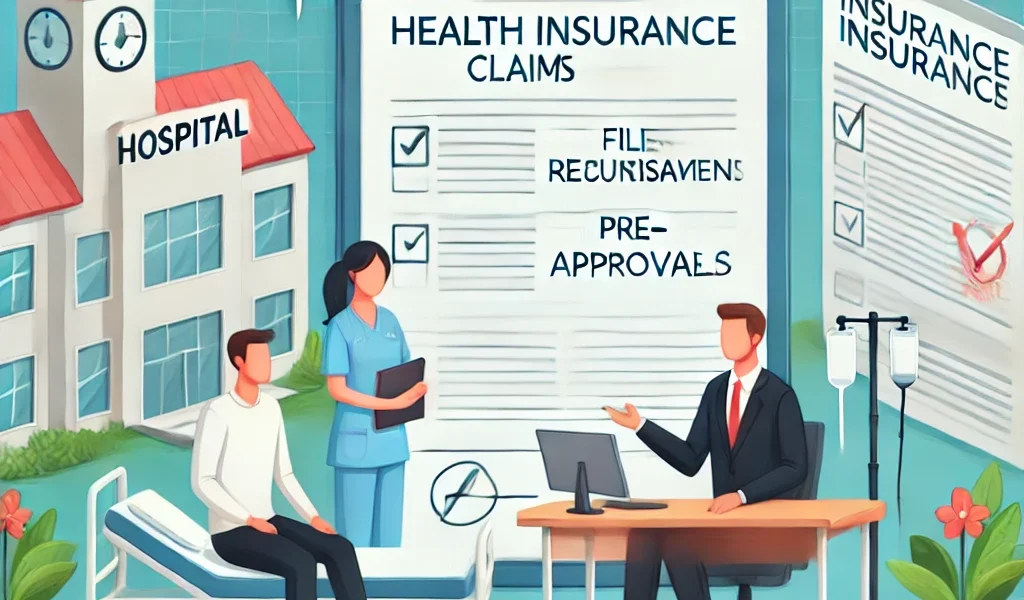Navigating health insurance claims can be complex, but understanding the process of reimbursement and pre-approvals can help you maximize your benefits and minimize out-of-pocket expenses. This DIY guide will walk you through the essential steps, ensuring you are well-prepared to handle your health insurance claims effectively.
1. Understanding Health Insurance Claims
A health insurance claim is a request submitted to your insurance provider for payment of medical expenses covered under your policy. Claims typically fall into two categories:
- Reimbursement Claims: You pay the medical expenses upfront and later request reimbursement from your insurer.
- Cashless Claims: The insurance provider directly settles the bill with the hospital if the treatment is taken in a network hospital.
By understanding these claim types, you can choose the best option based on your healthcare needs and financial situation.
2. What is a Reimbursement Claim?
A reimbursement claim requires you to pay your medical bills first and then seek repayment from your insurance provider. This method is useful when treatment occurs at a non-network hospital or when immediate hospitalization is necessary.
Step-by-Step Process for Filing a Reimbursement Claim
Step 1: Pay for the Medical Treatment
You must cover all expenses out of pocket before filing for reimbursement.
Step 2: Collect All Necessary Documents
To ensure smooth claim processing, gather the following:
- Original hospital bills and receipts
- Doctor’s prescriptions
- Discharge summary
- Diagnostic test reports
- Pharmacy bills
- Insurance policy details
Step 3: Fill Out the Claim Form
Most insurance companies provide a claim form, either online or offline. Fill it accurately to avoid rejection.
Step 4: Submit the Claim to the Insurance Provider
Send the completed claim form along with supporting documents to your insurer. Most companies allow submission via email, online portals, or postal mail.
Step 5: Follow Up on Your Claim
Check the status of your claim regularly to ensure timely processing. If there are discrepancies, the insurer may request additional documents.
Step 6: Receive Reimbursement
Upon approval, the insurer will transfer the claim amount to your registered bank account.
Common Reasons for Reimbursement Claim Rejection
- Submission of incomplete documentation
- Claiming expenses not covered under your policy
- Delay in claim submission
- Mismatch in details between hospital bills and claim form
3. What is a Pre-approval (Cashless) Claim?
A pre-approval claim, also known as a cashless claim, allows policyholders to receive medical treatment at network hospitals without making upfront payments. Instead, the insurer settles the bill directly with the hospital.
Step-by-Step Process for Filing a Cashless Claim
Step 1: Choose a Network Hospital
Verify if your insurance provider has a tie-up with the hospital where you plan to receive treatment.
Step 2: Inform Your Insurance Provider
Notify your insurer about the hospitalization and submit a pre-authorization request.
Step 3: Obtain Pre-approval
The hospital and insurer will coordinate to approve the treatment cost in advance. Ensure you submit the following documents:
- Policy details
- Medical reports
- Doctor’s recommendation
- Identity proof
Step 4: Receive Treatment Without Payment
Once the insurer approves the pre-authorization, you can undergo treatment without paying out of pocket (except for non-covered expenses).
Step 5: Settle Any Additional Costs
If certain expenses are not covered, you must pay them directly to the hospital.
Step 6: Verify and Sign Discharge Documents
Ensure that the final hospital bill matches your policy coverage before signing the discharge papers.
Common Reasons for Pre-approval Claim Denial
- Treatment not covered under policy
- Exceeding sum insured limit
- Hospital not included in the insurer’s network
- Failure to submit required documents in time
4. Key Differences Between Reimbursement and Cashless Claims
| Feature | Reimbursement Claim | Cashless Claim |
|---|---|---|
| Payment | You pay first and get reimbursed | Insurer directly settles the bill |
| Hospital Choice | Any hospital | Only network hospitals |
| Documentation | More paperwork required | Less paperwork required |
| Processing Time | Longer as documents need verification | Faster approval and settlement |
5. Tips to Ensure a Successful Health Insurance Claim
To avoid delays and rejections, follow these best practices:
1. Read Your Policy Carefully
Understand the inclusions, exclusions, and limits of your policy before filing a claim.
2. Keep All Medical Records
Maintain copies of all prescriptions, bills, and reports to support your claim.
3. Notify the Insurer Immediately
Report any planned or emergency hospitalization to your insurer at the earliest.
4. Follow the Claim Submission Timeline
Most insurers have a time limit for claim submissions—ensure you adhere to it.
5. Use Network Hospitals for Faster Settlement
Opt for cashless treatment at network hospitals to avoid the hassle of reimbursement claims.
6. Frequently Asked Questions (FAQs)
Q1: Can I file a reimbursement claim if I opted for cashless treatment but paid some bills?
Yes, you can claim reimbursement for expenses not covered under cashless settlement.
Q2: How long does it take to get health insurance claim approval?
Reimbursement claims typically take 7-21 days, while cashless claims are processed within 24-48 hours after approval.
Q3: What should I do if my claim is denied?
You can appeal the decision by submitting additional documents or contacting your insurer’s grievance cell.
Q4: Are there any tax benefits for health insurance claims?
Yes, under Section 80D of the Income Tax Act, you can claim tax deductions on health insurance premiums.
Q5: What expenses are not covered under health insurance?
Cosmetic surgeries, self-inflicted injuries, non-prescribed treatments, and alternative therapies may not be covered.
Final Thoughts
Understanding reimbursement and pre-approval claims can save you time, money, and unnecessary stress during medical emergencies. By following the right procedures and keeping all necessary documents handy, you can ensure a hassle-free claim process. Whether you choose cashless treatment or reimbursement, always stay informed about your policy to maximize your benefits.



